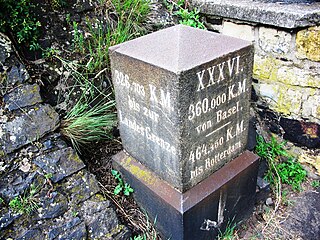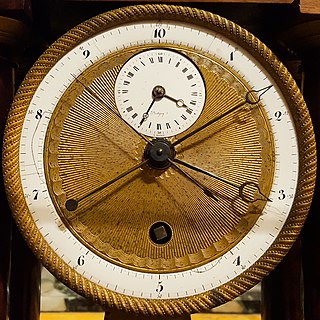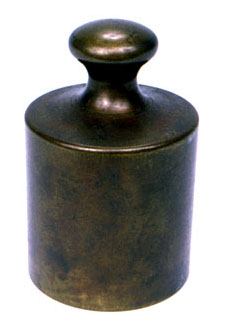
The kilogram is the base unit of mass in the International System of Units (SI), having the unit symbol kg. It is a widely used measure in science, engineering and commerce worldwide, and is often simply called a kilo colloquially. It means 'one thousand grams'.

The litre or liter is a metric unit of volume. It is equal to 1 cubic decimetre (dm3), 1000 cubic centimetres (cm3) or 0.001 cubic metre (m3). A cubic decimetre occupies a volume of 10 cm × 10 cm × 10 cm and is thus equal to one-thousandth of a cubic metre.

The metre is the base unit of length in the International System of Units (SI). Since 2019 the metre has been defined as the length of the path travelled by light in vacuum during a time interval of 1/299792458 of a second, where the second is defined by a hyperfine transition frequency of caesium.
The International System of Units, internationally known by the abbreviation SI, is the modern form of the metric system and the world's most widely used system of measurement. Established and maintained by the General Conference on Weights and Measures, it is the only system of measurement with an official status in nearly every country in the world, employed in science, technology, industry, and everyday commerce.
A metric prefix is a unit prefix that precedes a basic unit of measure to indicate a multiple or submultiple of the unit. All metric prefixes used today are decadic. Each prefix has a unique symbol that is prepended to any unit symbol. The prefix kilo-, for example, may be added to gram to indicate multiplication by one thousand: one kilogram is equal to one thousand grams. The prefix milli-, likewise, may be added to metre to indicate division by one thousand; one millimetre is equal to one thousandth of a metre.

The metric system is a system of measurement that is a decimal system. The current international standard for the metric system is the International System of Units, in which all units can be expressed in terms of seven base units. The units that serve as the SI base units are the metre, kilogram, second, ampere, kelvin, mole, and candela.

Metric time is the measure of time intervals using the metric system. The modern SI system defines the second as the base unit of time, and forms multiples and submultiples with metric prefixes such as kiloseconds and milliseconds. Other units of time – minute, hour, and day – are accepted for use with SI, but are not part of it. Metric time is a measure of time intervals, while decimal time is a means of recording time of day.

Jean-Charles, chevalier de Borda was a French mathematician, physicist, and Navy officer.

The gram is a unit of mass in the International System of Units (SI) equal to one thousandth of a kilogram.
Centi- is a unit prefix in the metric system denoting a factor of one hundredth. Proposed in 1793, and adopted in 1795, the prefix comes from the Latin centum, meaning "hundred". Since 1960, the prefix is part of the International System of Units (SI). It is mainly used in combination with the unit metre to form centimetre, a common unit of length.
Milli is a unit prefix in the metric system denoting a factor of one thousandth (10−3). Proposed in 1793, and adopted in 1795, the prefix comes from the Latin mille, meaning one thousand. Since 1960, the prefix is part of the International System of Units (SI).

Myria- (symbol my) is a now obsolete decimal metric prefix denoting a factor of 104 (ten thousand). It originates from the Greek μύριοι (mýrioi) (myriad). The prefix was part of the original metric system adopted by France in 1795, but was not adopted when the SI prefixes were internationally adopted by the 11th CGPM conference in 1960.
A unit prefix is a specifier or mnemonic that is prepended to units of measurement to indicate multiples or fractions of the units. Units of various sizes are commonly formed by the use of such prefixes. The prefixes of the metric system, such as kilo and milli, represent multiplication by positive or negative powers of ten. In information technology it is common to use binary prefixes, which are based on powers of two. Historically, many prefixes have been used or proposed by various sources, but only a narrow set has been recognised by standards organisations.

France has a unique history of units of measurement due to its radical decision to invent and adopt the metric system after the French Revolution.

Decimal time is the representation of the time of day using units which are decimally related. This term is often used specifically to refer to the French Republican calendar time system used in France from 1794 to 1800, during the French Revolution, which divided the day into 10 decimal hours, each decimal hour into 100 decimal minutes and each decimal minute into 100 decimal seconds, as opposed to the more familiar standard time, which divides the day into 24 hours, each hour into 60 minutes and each minute into 60 seconds.

The grave, abbreviated gv, is the unit of mass used in the first metric system which was implemented in France in 1793. In 1795, the grave was renamed as the kilogram.

The hectare is a non-SI metric unit of area equal to a square with 100-metre sides (1 hm2), that is, 10,000 square meters, and is primarily used in the measurement of land. There are 100 hectares in one square kilometre. An acre is about 0.405 hectares and one hectare contains about 2.47 acres.

The history of the metric system began during the Age of Enlightenment with measures of length and weight derived from nature, along with their decimal multiples and fractions. The system became the standard of France and Europe within half a century. Other measures with unity ratios were added, and the system went on to be adopted across the world.

The following outline is provided as an overview of and topical guide to the metric system:
Hebdo- (symbol H) is an obsolete decimal metric prefix equal to 107. It is derived from the Greek hebdοmos (Greek: ἕβδομος) meaning seventh.













